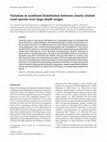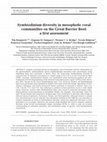Papers by Francisca Vermeulen
2023 IEEE 21st International Conference on Industrial Informatics (INDIN)

Molecular Ecology, 2007
Symbiotic algae in coral species distributed over a large depth range are confronted with major d... more Symbiotic algae in coral species distributed over a large depth range are confronted with major differences in light conditions. We studied the genetic variation of Symbiodinium in the coral genus Madracis over depth (5-40 m) and at two different colony surface positions. Using polymerase chain reaction-denaturing gradient gel electrophoresis ITS2 nuclear ribosomal DNA analyses, we consistently identified three symbiont genotypes with distributions that reveal patterns of host specificity and depth-based zonation. ITS2 type B7 Symbiodinium is the generalist type, occurring in all zooxanthellate Madracis corals and at all depths. Type B13 is restricted to the shallow water specialist Madracis mirabilis. Type B15 is typical of deep reef environments and replaces B7 in the depth generalist Madracis pharensis. Contrasting with variation over depth, we found strong functional within-colony uniformity in symbiont diversity. Relating symbiont distributions to measured physical factors (irradiance, light spectral distribution, temperature), suggests depth-based ecological function and host specificity for Symbiodinium ITS2 types, even among closely related coral species.

Marine Ecology Progress Series, 2011
Despite a growing interest in mesophotic coral ecosystems (MCEs), information on the photosynthet... more Despite a growing interest in mesophotic coral ecosystems (MCEs), information on the photosynthetic endosymbionts (genus Symbiodinium) associated with scleractinian corals inhabiting deep reef ecosystems is sparse. Here, the deep-water Symbiodinium diversity is assessed from 10 different coral genera at a depth range of 45 to 70 m on the Great Barrier Reef (GBR), Australia. Symbiodinium identity was established using denaturing gradient gel electrophoresis (DGGE) fingerprinting of the internal transcribed spacer region 2 (ITS2) of the ribosomal DNA. Except for the novel Symbiodinium type C131 (found in Porites), all Symbiodinium types have previously been identified in shallow reef corals across the Pacific. Specimens of Seriatopora, Montipora, and Porites harboured similar symbionts as reported in shallow water (e.g. C3n, C3n-hh, C15, and C17), thus adhering to patterns of host-specificity across a wide depth range. However, several other Symbiodinium types were found to transcend previously established patterns of host-specificity at mesophotic depths. For example, 'host-specialist' types C3i and C3k (previously only reported in Acropora spp.) were found here to associate with a range of different genera (Leptoseris, Pachyseris, Fungia, and Echinophyllia). Although limited in sample size, this preliminary survey indicates that mesophotic habitats on the GBR may not represent an isolated community in terms of Symbiodinium diversity, which has significant relevance to their potential to act as refugia. Moreover, the present study identifies the need to examine symbiont diversity across broad environmental ranges (including MCEs) in order to gain an accurate understanding of symbiosis specificity and distribution range of specific coral-Symbiodinium associations.
CERN European Organization for Nuclear Research - Zenodo, Feb 23, 2023

Background: Coral reefs are hotspots of biodiversity, yet processes of diversification in these e... more Background: Coral reefs are hotspots of biodiversity, yet processes of diversification in these ecosystems are poorly understood. The environmental heterogeneity of coral reef environments could be an important contributor to diversification, however, evidence supporting ecological speciation in corals is sparse. Here, we present data from a widespread coral species that reveals a strong association of host and symbiont lineages with specific habitats, consistent with distinct, sympatric gene pools that are maintained through ecologically-based selection. Methodology/Principal Findings: Populations of a common brooding coral, Seriatopora hystrix, were sampled from three adjacent reef habitats (spanning a,30 m depth range) at three locations on the Great Barrier Reef (n = 336). The populations were assessed for genetic structure using a combination of mitochondrial (putative control region) and nuclear (three microsatellites) markers for the coral host, and the ITS2 region of the rib...
xiii Chapter 1 General introduction 1 The polar environments 1 Sea ice formation 3 The sea ice ha... more xiii Chapter 1 General introduction 1 The polar environments 1 Sea ice formation 3 The sea ice habitat 5 Primary production 7 Nutrients 10 Silicon 11 Climate change in polar regions 13 Aims and thesis overview 15 Chapter 2 Spatial and temporal comparisons of sea ice algal communities in the Ross Sea, Antarctica 18 Abstract 18 18 Introduction 18 Methods 21 Sample locations 21 Sampling 23 Radiometry 24 Statistics 24 Results 25 Vertical position within the sea ice 25 Radiometry 26 Locations 28
Uploads
Papers by Francisca Vermeulen